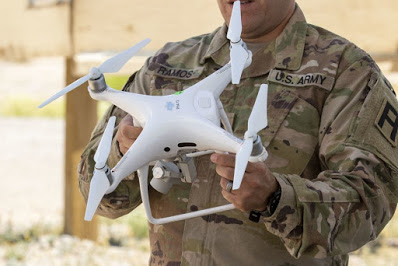The sky is getting congested. Rapid increases in the number and type of drones in the air is leading to new challenges when it comes to determining friend or foe, both at home and abroad. With uses ranging from benign recreation, to far more alarming applications like gathering intelligence or wreaking havoc on a battlefield, these readily available and inexpensive small Unmanned Aircraft Systems (sUAS) are easily operated and growing in popularity. Nancy Jones-Bonbrest, U.S. Army Rapid Capabilities and Critical Technologies Office, reports.
Follow Army Recognition on Google News at this link

Soldiers from 5th Armored Brigade, 1st Army Division West, developed a course of instruction to counter the threat of commercial, off-the-shelf unmanned aerial surveillance vehicles at McGregor Range Complex, N.M., June 28, 2019. On October 30 , 2020, the Department of Defense outlined its approach for Counter-small Unmanned Aircraft Systems (sUAS) during a virtual industry open house (Picture source : U.S. Army/Staff Sgt. Mylinda DuRousseau)
To answer these challenges and more, the U.S. Department of Defense is working towards synchronized solutions that can quickly and accurately detect, track, identify, and if necessary, defeat sUAS hazards and threats. Stressing the need for an enterprise approach across the services for its Counter-sUAS (C-sUAS) efforts, the Department of Defense held an Industry Open House on October 30. More than 500 industry representatives from small and large businesses logged into the virtual event to hear leaders and subject matter experts lay out their plans in establishing joint solutions within a common architecture to address growing sUAS threats.
“We’ve got to be agile as the adversary changes his technology, his tactics, his techniques, and his procedures,” said GEN Joseph Martin, Vice Chief of Staff of the Army, in a pre-recorded address to C-sUAS Industry Open House participants. “To get after this enterprise effort, we’ve got to work closely together as a team of teams across the Joint force.”
This first-ever C-sUAS industry open house was co-hosted by the Joint C-sUAS Office (JCO), which leads and directs efforts to identify and prioritize joint C-sUAS solutions, and the Army Rapid Capabilities and Critical Technologies Office (RCCTO), which leads materiel and acquisition support for the JCO. The event provided information on emerging requirements, strategy, training, on-ramp opportunities for industry, and numerous other areas.
Instead of pursuing C-sUAS efforts from an individual service perspective, the Department will instead move forward in a collaborative way, with all of the services pursuing long-term Joint C-sUAS solutions together, said MG Sean Gainey, director of the JCO.
The Department of Defense has finalized its C-sUAS operational requirements document and is in the final stages of approving its C-sUAS strategy, speakers said. The requirements – coordinated with all services, Combatant Commands, and other DoD stakeholders – will provide parameters that address current and future capabilities required within a modular, open system command and control architecture, JCO officials explained. The strategy, once complete, will bring a framework for addressing sUAS across the spectrum and in locations that include the United States, host nations and contingency areas.
“The speed at which this is happening is dramatic,” LTG L. Neil Thurgood, director of Hypersonics, Directed Energy, Space and Rapid Acquisition, who oversees the RCCTO, said during the industry event. “That speed is focused, that speed is resourced, and that speed will bring the results we need.”
Those participating in the Industry Open House had the opportunity to submit questions online in advance, which were answered during the event. Topics ranged from how the JCO will stay ahead of the rapidly moving sUAS threat, the timeline for initial efforts and requirements for future solutions.
In June, DoD leadership approved the results of an operational assessment of C-sUAS capabilities currently in the field, and is proceeding with ten initial joint C-sUAS systems for continued investments. In laying out the current challenges faced by the C-sUAS community, stakeholders hope to bring a common approach with the ultimate goal of joint coordinated investment in the best system performance and capability mix. With industry’s assistance, the DoD will decrease overlap, increase efficiencies and provide common architectures and interfaces for intuitive capabilities across all services.
Moving forward, three common test ranges have been selected and a task force was also established to identify possible urban test locations, officials said. The JCO and RCCTO expect to have one to two test events per year, with the first slated for the second quarter of Fiscal Year 2021. Such events will provide industry with on-ramp opportunities for technology transition.
“If your company has a product that addresses one of our opportunities, then you will be potentially invited to demonstrate that capability solution at a Joint common test range and evaluate it against common test protocols,” said COL Greg Soule, RCCTO director of the Acquisition & Resources Division in support of the JCO.














